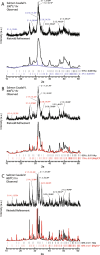Formation of Biphasic Hydroxylapatite-Beta Magnesium Tricalcium Phosphate in Heat Treated Salmonid Vertebrae
- PMID: 28620190
- PMCID: PMC5472584
- DOI: 10.1038/s41598-017-03737-2
Formation of Biphasic Hydroxylapatite-Beta Magnesium Tricalcium Phosphate in Heat Treated Salmonid Vertebrae
Abstract
Ichthyoarchaeological evidence is uncommon at ancient hunter-gatherer sites from various regions and timeframes. This research contributes to the development of microarchaeological techniques useful for identifying fishing economies in situations where classifiable bones are unavailable. Specifically, traces of heat altered bone mineral in domestic hearths are expected to provide markers for discarded fish remains. We used a series of laboratory incineration experiments to characterize the mineralogy of burned salmonid vertebrae. Fourier transform infrared spectroscopy and x-ray diffraction distinguished the formation of beta magnesium tricalcium phosphate (βMgTCP) at temperatures as low as 600 °C. Bones from a sample of game mammals and birds did not form this phase at temperatures below 1,000 °C. We propose that this neoformed mineral can serve as a proxy for hunter-gatherer salmonid fishing when typical ichthyoarchaeological evidence is absent. Using Fourier transform infrared spectroscopy, it will be possible to rapidly and inexpensively determine the presence of βMgTCP in fragmentary burned bone remains associated with combustion features. The occurrence of βMgTCP in archaeological hearth features will offer a new means of further evaluating the temporal, geographic, and cultural scope of salmonid harvesting. We also acknowledge the value of biphasic hydroxylapatite-βMgTCP recovered from Atlantic salmon vertebrae as a bioceramic.
Conflict of interest statement
The authors declare that they have no competing interests.
Figures







Similar articles
-
Early Evidence for Northern Salmonid Fisheries Discovered using Novel Mineral Proxies.Sci Rep. 2019 Jan 16;9(1):147. doi: 10.1038/s41598-018-36133-5. Sci Rep. 2019. PMID: 30651595 Free PMC article.
-
Solubility of Mg-containing beta-tricalcium phosphate at 25 degrees C.Acta Biomater. 2009 Jan;5(1):508-17. doi: 10.1016/j.actbio.2008.06.010. Epub 2008 Jul 2. Acta Biomater. 2009. PMID: 18644755 Free PMC article.
-
β-tricalcium phosphate and octacalcium phosphate composite bioceramic material for bone tissue engineering.J Biomater Appl. 2020 Apr;34(9):1294-1299. doi: 10.1177/0885328220903989. Epub 2020 Feb 6. J Biomater Appl. 2020. PMID: 32028822 No abstract available.
-
The thermal stability of hydroxyapatite in biphasic calcium phosphate ceramics.J Mater Sci Mater Med. 2008 Apr;19(4):1693-702. doi: 10.1007/s10856-007-3252-x. Epub 2007 Sep 25. J Mater Sci Mater Med. 2008. PMID: 17899322
-
Resorbable bioceramics based on stabilized calcium phosphates. Part I: rational design, sample preparation and material characterization.Biomaterials. 1999 Sep;20(18):1727-41. doi: 10.1016/s0142-9612(99)00086-1. Biomaterials. 1999. PMID: 10503974 Review.
Cited by
-
Impacts of pre-treatment methods on the morphology, crystal structure, and defects formation of hydroxyapatite extracted from Nile tilapia scales.RSC Adv. 2024 Feb 5;14(7):4614-4622. doi: 10.1039/d3ra07556g. eCollection 2024 Jan 31. RSC Adv. 2024. PMID: 38318621 Free PMC article.
-
Early Evidence for Northern Salmonid Fisheries Discovered using Novel Mineral Proxies.Sci Rep. 2019 Jan 16;9(1):147. doi: 10.1038/s41598-018-36133-5. Sci Rep. 2019. PMID: 30651595 Free PMC article.
-
Spectral Analysis of Strontium-Doped Calcium Phosphate/Chitosan Composite Films.Polymers (Basel). 2023 Oct 28;15(21):4245. doi: 10.3390/polym15214245. Polymers (Basel). 2023. PMID: 37959925 Free PMC article.
-
Unraveling the structural complexity of and the effect of calcination temperature on calcium phosphates derived from Oreochromis niloticus bones.Heliyon. 2024 Apr 13;10(8):e29665. doi: 10.1016/j.heliyon.2024.e29665. eCollection 2024 Apr 30. Heliyon. 2024. PMID: 38644889 Free PMC article.
-
Effect of vacancies on blue-colored calcium phosphate scaffolds derived from Nile tilapia bone powder.Sci Rep. 2025 Jul 5;15(1):24058. doi: 10.1038/s41598-025-99708-z. Sci Rep. 2025. PMID: 40617969 Free PMC article.
References
-
- Msangi, S. et al. Fish to 2030: prospects for fisheries and aquaculture. http://www.fao.org/docrep/019/i3640e/i3640e.pdf (World Bank, 2013).
-
- Food and Agriculture Organization of the United Nations, Species Fact Sheet, Atlantic Salmon. http://www.fao.org/fishery/species/2929/en (2016).
-
- Katz, J. Salmon farming in Chile. In Technology, Adaptation, and Exports - How Some Developing Countries Got it Right (eds Chandra, V. & Kolavalli, S.) (World Bank, 2006).
Publication types
MeSH terms
Substances
LinkOut - more resources
Full Text Sources
Other Literature Sources

